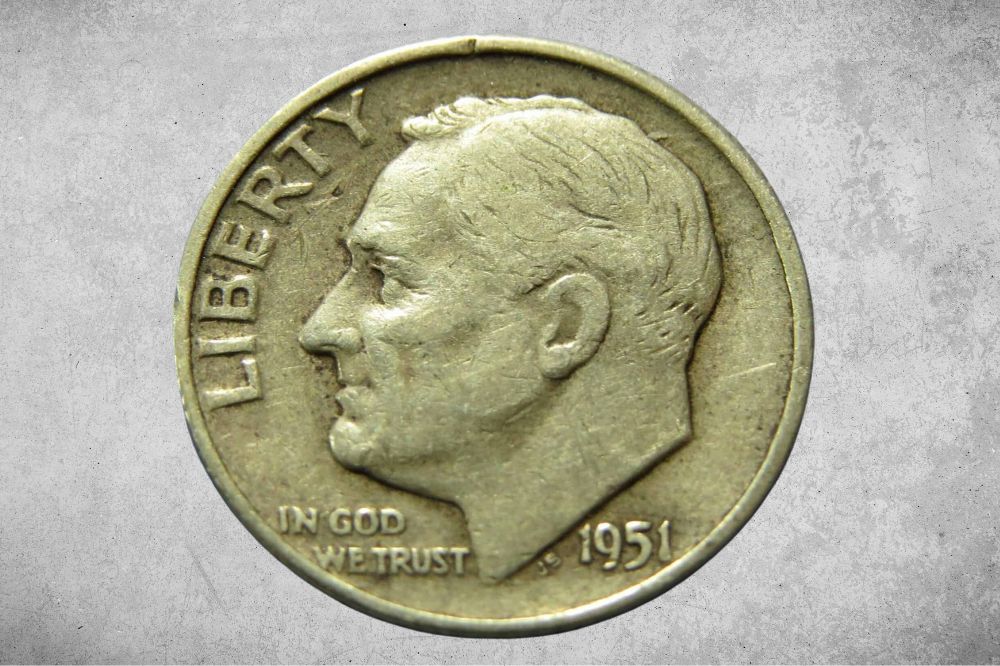The 1951 dime has captivated coin collectors due to its rarity, worth, and numerous states of preservation. It is a loved piece in numismatics that holds unique features. As time passes, this vintage coin continues to grow in desirability and value amongst enthusiasts everywhere.
In this blog post, we will explore nearly everything there is to know about the 1951 dime. We will discover the dime’s worth, rareness, condition types available for purchase, and error varieties associated with them, as well as other interesting facts about this coin from 1951!
Are you ready to get started? Then let’s go!
1951 Dime Details
- Category: Roosevelt dime
- Mints: Philadelphia, Denver, and San Francisco
- Total Mintage: 180 million+
- Obverse designer: John R. Sinnock
- Reverse designer: John R. Sinnock
- Edge: Reeded
- Diameter: 17.9 millimeters (0.7087 inches)
- Thickness: 1.35 millimeters (0.0532 inches)
- Composition: silver (90% silver, 10% copper)
- Weight: 2.5 grams
The 1951 dime was part of the Roosevelt Dime series which began in 1946 when Franklin Delano Roosevelt’s portrait first appeared on U.S. coins minted that year. The 1951 version features both an obverse (front) and reverse (back). It also contains some errors that make certain versions even more desirable among numismatists.
The 1951 Roosevelt dime is a popular collector’s item due to its age and history. The obverse of the 1951 dime features the profile of President Franklin Delano Roosevelt, with the word “LIBERTY” inscribed above and to the left. The reverse of the 1951 dime features an olive branch, oak branch, and a torch, which are symbols often associated with freedom and peace.
The design was from John R. Sinnock, a well-known engraver who designed several coin designs in the 20th century. The reeded-edge coin has a diameter of 17.9 millimeters, a thickness of 1.35 millimeters, and weighs 2.5 grams.
Lastly, it is made up of 90% silver and 10% copper, which is different from dimes made today, which are a composition of 90% copper and 10% nickel. This means that 1951 dimes are worth more than regular dimes in circulation.
1951 Dime Value Chart |
|||||
| Mint Mark | Good | Fine | Extremely Fine | Uncirculated | Proof |
| 1951 “No Mint Mark” Dime | $2.59 | $3.67 | $4.20 | $6.38 – $12 | $57 |
| 1951 “D” Dime | $2.66 | $3.74 | $4.27 | $6.45 – $12 | / |
| 1951 “S” Dime | $2.66 | $3.74 | $5.24 | $9.96 – $29 | / |
1951 Dime Value and Varieties Guide
This 1951 Roosevelt dime can be found in various levels of condition, including Good, Fine, Extremely Fine, and Uncirculated. Each level is determined by how much wear or damage has occurred over time. Collectors seek out coins in higher grades for their collections as they are seen as more valuable than those in lower grades.
Let’s check them out in more detail:
1951 “No Mint Mark” Dime
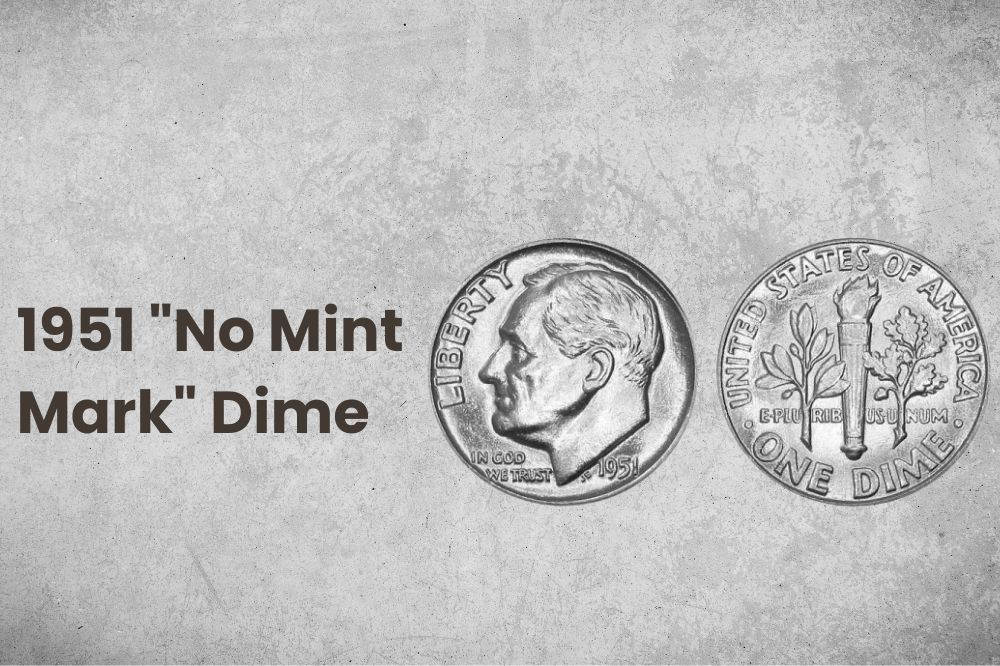
- Type: Roosevelt dime
- Edge: Reeded
- Mint mark: None
- Place of minting: Philadelphia
- Year of minting: 1951
- Face value: $0.10
- $ price: $2.59 to $57
- Quantity produced: 102,937,602
- Designer: John R. Sinnock
The “No Mint Mark” dime from 1951 is a fairly prevalent coin, having been minted 100 million times that year. It is valued at different levels depending on the condition it is found in. In “Good” condition, 1951 dimes are typically worth around $2.59, while 1951 dimes in “Fine” condition can be worth up to $3.67 or more.
1951 dimes in “Extremely Fine” condition have a value of up to $4.20, and those that have been “Uncirculated” can be worth even more – from $6.38 up to $12 for 1951 dimes with no mint mark!
There was also a Proof coin this year which increased the 1951 dime value significantly. 1951 Proof dimes can fetch prices at $57 or more, making them some of the most valuable 1951 Roosevelt dimes available. In fact, one in extremely pristine cameo shape sold at an auction for over $23,000!
1951 “D” Dime
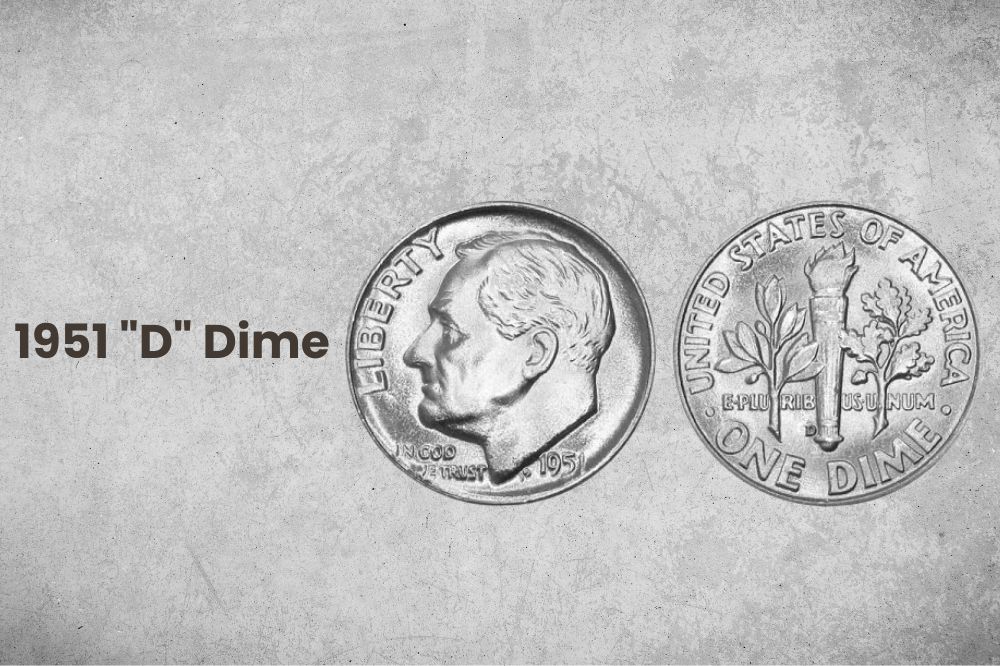
- Type: Roosevelt dime
- Edge: Reeded
- Mint mark: D
- Place of minting: Denver
- Year of minting: 1951
- Face value: $0.10
- $ price: $2.66 – $12
- Quantity produced: 56,529,000
- Designer: John R. Sinnock
The 1951 D dime was one of 56.5 million coins that were minted in Denver that year. Like the “No Mint Mark” version, this 1951 D dime can be found in various levels of condition and is valued according to its condition level.
1951 D dimes in “Good” condition are worth up to $2.66, 1951 D dimes in “Fine” condition can be worth up to $3.74 or more, 1951 D dimes in “Extremely Fine” condition have a value of up to $4.27 and those that have been “Uncirculated” can be worth even more – from $6.45 to $12!
1951 “S” Dime
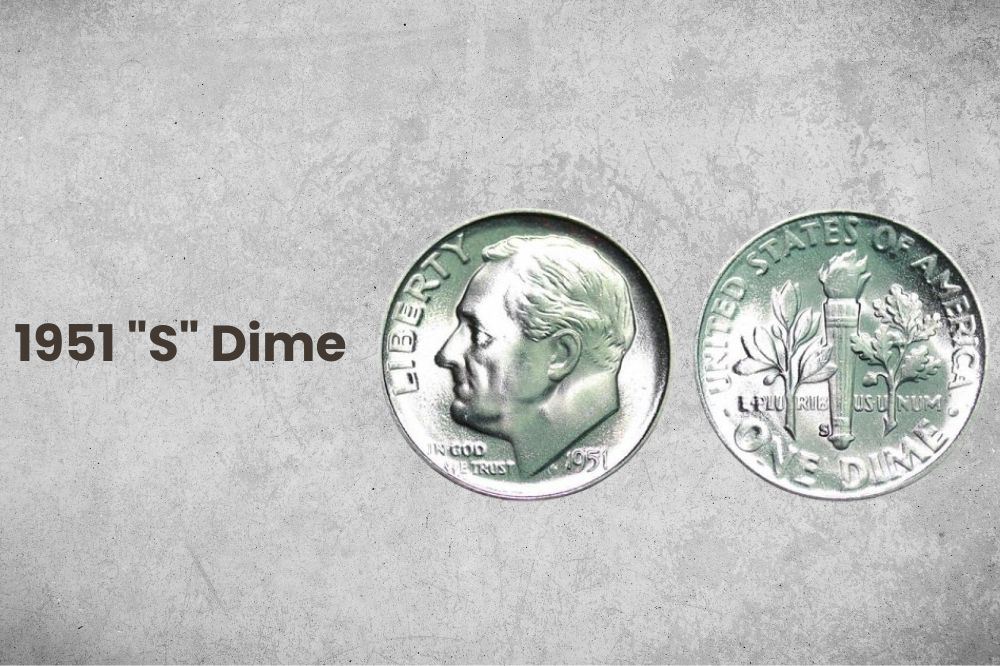
- Type: Roosevelt dime
- Edge: Reeded
- Mint mark: S
- Place of minting: San Francisco
- Year of minting: 1951
- Face value: $0.10
- $ price: $2.66 – $29
- Quantity produced: 31,630,000
- Designer: John R. Sinnock
In 1951, the San Francisco mint produced 31.6 million S marked dimes – but don’t expect to see them all in pristine condition! Their value is based largely on how well they are preserved, so you’re likely to find some specimens that have aged better than others. Whether they’ve weathered time well or not, though, these coins remain a valuable and collectible piece of history.
1951 S dimes in “Good” condition are worth up to $2.66, 1951 S dimes in “Fine” condition can be worth up to $3.74, 1951 S dimes in “Extremely Fine” condition can be worth up to $5.24, and those graded “Uncirculated” may command a higher price from $9.96 all the way up to an impressive $29!
History of the 1951 Dime
This dime was minted in 1951 and is part of the Roosevelt dimes series. It first appeared on coinage in 1946 when it replaced the Mercury dime, which had been used since 1916. The 1951 dime features a profile of President Franklin Delano Roosevelt on the obverse side and three symbols of freedom on the reverse side: an olive branch, oak branch, and a torch.
It was designed by John R. Sinnock, who also designed the Franklin half dollar and other coins during his time as Chief Engraver at The United States Mint from 1925 to 1947. In 1951, more than 180 million 1951 dimes were produced – including 56 million 1951 D dimes that were minted at the Denver Mint and 102 million “No Mint Mark” 1951 dimes that were minted at the Philadelphia Mint for business circulation.
Also Read: Top 15 Most Valuable Roosevelt Dimes Worth Money
1951 Dime Grading
Grading 1951 dimes is a process used to determine the condition and Monetary value of 1951 dimes. 1951 dimes are graded based on how worn or damaged they are, as well as any special features such as errors. The condition of 1951 dimes can be divided into four main categories: Good, Fine, Extremely Fine, and Uncirculated.
“Good” 1951 dimes have wear visible on both the obverse and reverse sides. These coins may have significant scratches or marks from contact with other coins over their lifetime. 1951 dimes in this condition may still retain some mint luster but will generally have low eye appeal.
“Fine” 1951 dimes show some of the wear from circulation but still retain much of the original detail on both sides. They will also have some minor damage, such as nicks and scratches, but these should not detract significantly from the overall design.
“Extremely Fine” 1951 dimes show minimal wear with most of the original detail still present on both sides. These coins will look almost new in appearance with only minor evidence of contact with other coins.
“Uncirculated” 1951 dimes show no wear at all and are often referred to as uncirculated or mint state coins. These coins were never circulated and display full mint luster on both sides with no signs of damage or wear whatsoever.
Another thing that factors into grading is if it’s a Proof coin. Proof 1951 dimes were specially struck for collectors using dies that were polished to a mirror-like finish before striking each coin multiple times in high relief against highly polished blanks known as planchets (or ‘planchette’). These coins often display “cameo” effects due to different metals striking each side differently when struck multiple times for Proofs, and they can be worth a lot more than circulated coins.
Finally, there are error coins. Error 1951 dimes display mistakes made in production that cause them to differ significantly from standard issue 1951 dimes in terms of design details or composition flaws. Errors can range from slight differences in size or shape to major design changes resulting from missing details or reversed images (known as “die rotation errors”).
Error 1951 dimes can be very valuable depending on how rare they are and what type of error they display.
1951 Dime Error Coins
As we briefly mentioned earlier, 1951 dimes may have certain errors associated with them. Such errors could include anything from die cracks to weak strikes during manufacturing which make certain versions even rarer and more sought after by numismatists.
There are several 1951 dime error varieties that can be found in circulated condition as well as higher grades. Let’s look at just a couple of them:
1951 Dime – Repunched Mint Mark Error
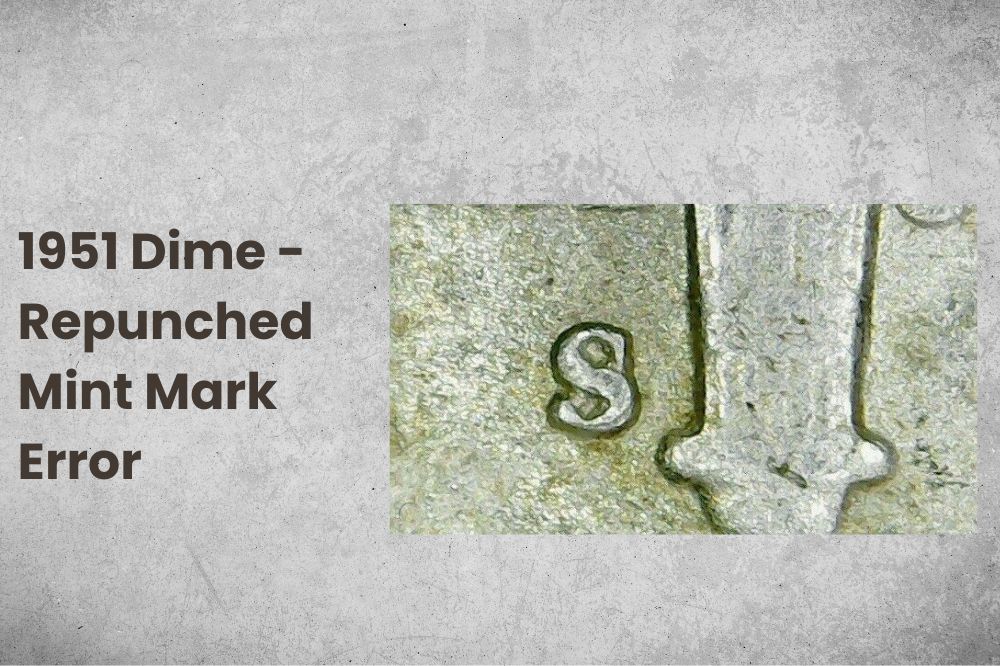
There is known to be a 1951 S dime, as well as a 1951 D dime, that has a mint mark that has been punched twice. The S (or D), which is on the reverse of the dime, to the left of the torch, has been stamped more than once on some varieties, and it can only be seen with a coin microscope.
These are believed to go for more than the standard 1951 dime is worth, but it really depends on their condition. For example, a high grade 1951 dime with a D repunched mint mark sold in recent years for about $70.
1951 Dime – Full Bands Variety
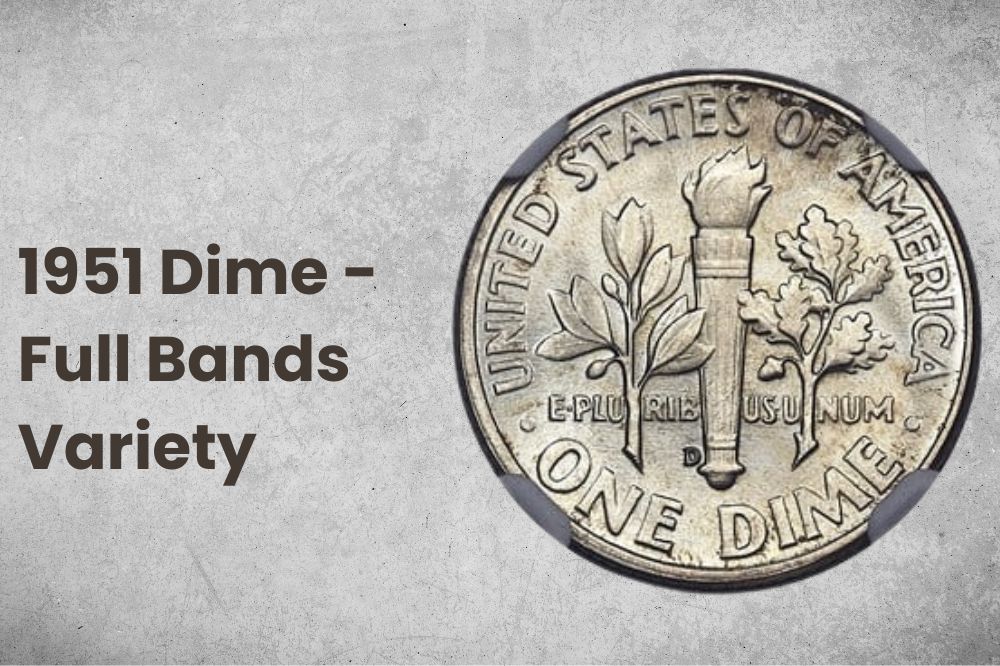
While this isn’t really an error, we are adding it here because it’s one of the most sought-after varieties of 1951 dimes. A coin with “full bands” means that the torch on the back of the dime is in such good condition that you can clearly make out all of the horizontal lines that go across the torch. Of course, you will only be able to see them on dimes that are in mint state, and they are thus worth a lot of money.
One such coin with an extremely high grade sold at an auction for over $4,600! Not bad for a little ten cent piece, right?
Frequently Asked Questions About 1951 Dimes
Now that you know more about 1951 dimes, here are a few frequently asked questions about 1951 dimes.
Where Can I Find 1951 Dimes to Purchase?
1951 dimes can be found for sale at many online coin stores or marketplaces like Etsy, as well as in the numismatic section of your local coin shop. You may also wish to look on auction sites such as eBay or Heritage Auctions, where you may find 1951 dimes that are especially rare or valuable.
Should I Clean My 1951 Dimes?
1951 dimes should never be cleaned or polished, as this can significantly reduce their value. If you have 1951 dimes that need to be cleaned, it is best to leave them to a professional coin dealer.
Conclusion
All in all, the 1951 Roosevelt dime is a unique part of American coinage history, and its value continues to increase among collectors and numismatists alike! They honor President Franklin Delano Roosevelt and continue the tradition of producing circulating coinage with his image. Excitingly, they are made of 90% silver, which is more than we can say for dimes made in today’s market.
1951 dimes come in a variety of conditions ranging from “Good” to “Uncirculated,” and of course, there are error coins as well, each with their own unique values based on grade and condition. And if you are just hopping into the coin collecting niche, you may want to add a few of these 1951 dimes to your collection due to their relative affordability and availability at this time.
So, if you are looking for an interesting coin to add to your existing collection, then 1951 Roosevelt dimes could be the perfect fit!
Good luck and happy collecting!
Do you have a 1951 dime already? Tell us about them in the comments below!
